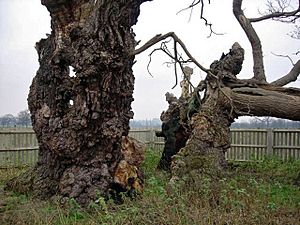Hampton Court Park facts for kids
| Site of Special Scientific Interest | |
 |
|
| Area of Search | Greater London |
|---|---|
| Interest | Biological |
| Area | 88.9 hectares |
| Notification | 2014 |
| Location map | Magic Map |

Hampton Court Park is a large, historic royal park in south west London, England. It is managed by the Historic Royal Palaces and is a special place for wildlife. The park is located between the famous Hampton Court Palace and the towns of Kingston upon Thames and Surbiton. Most of it is in East Molesey, but a small part reaches into Kingston.
In 2014, parts of Hampton Court Park, along with Bushy Park and Hampton Court Golf Course, were named a Site of Special Scientific Interest (SSSI). This means they are important for their plants and animals. The park sits on a bend of the River Thames. It includes a golf course, open meadows with trees, and areas where deer graze. Horses also graze here in certain seasons. A part of the park hosts the Hampton Court Flower Show every year. Near the palace, you'll find the Long Water, which is a series of lakes built long ago. These lakes get their water from the River Colne, far away.
Contents
What is Hampton Court Park Like?
Hampton Court Park is a very old deer park that is surrounded by a wall. It covers about 700 acres (1.1 square miles). The park is home to a herd of fallow deer. It has been open for everyone to visit since 1894. Along the northern wall, near the A308 road, there are many trees. Most of these trees lose their leaves in autumn.
How the Park Was Created
Long ago, Cardinal Wolsey built a grand house where Hampton Court Palace now stands. He also built walls around about 2,000 acres of land to create this park and Bushy Park. When King Henry VIII took over the palace, he loved to hunt. He used the park to raise rabbits, hares, pheasants, and partridges for hunting.
In 1659, a record showed there were about 700 deer in Hampton Court Park. This was fewer than in Bushy Park, which had about 1,700 deer at that time.
The Ancient Mediaeval Oak Tree
In the southern part of the park, there is a very old tree called the Mediaeval Oak. Some people also call it Methuselah's Oak. This amazing tree is thought to be around 750 years old! It stands near one of the golf course areas.
Water Features and Flood Protection
The park is next to the River Thames, just above Teddington Lock. A public path runs along the river here. Most of the park is a "flood meadow." This means it can get flooded during very heavy rains. While it's not a special "Flood Storage Area," it is in a flood risk zone. A small part of the park has a high chance of flooding each year.
North of the main road, there are some smaller fields called Paddocks. These are next to Bushy Park. The Royal Mews, which cares for the King's horses, often lets horses graze in the park during the summer months.
The Long Water is a gentle stream that flows through the park. It starts behind Hampton Court Palace and ends at the Golden Jubilee Fountain. This water is connected underground to the Longford River. This river also feeds water features in nearby Bushy Park, like the Diana Fountain, Bushy Park.
Hampton Court Palace Flower Show
Every year, a big event called the Hampton Court Palace Flower Show takes place in the park. It uses about 25 acres of the park's land. The Royal Horticultural Society organizes this show, and it first started in 1990.
Many people enjoy this flower show even more than the famous Chelsea Flower Show. This is because Hampton Court has more space, and visitors can buy plants and gardening tools right at the show. It is known as the world's most popular event of its kind. Because so many people visit, there can sometimes be long traffic jams. Some people have worried that the show might harm the park's historic features.
Images for kids



